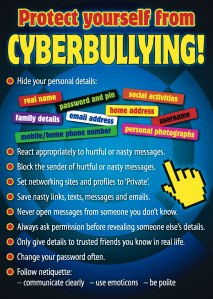Cyberbullying is an aggressive, intentional act, that is carried out repeatedly by one person or a group through the use of electronic devices such as mobile phones, and computers (Smith, Mahdavi, Carvalho, Fisher, Russel & Tippet, 2008, p. 376., as cited in Dooley, Pyzalski & Cross, 2009). This bullying mostly occurs through chat rooms, Facebook, Twitter, text messaging and more. Cyberbullying is increasing due to the bully being able to stay anonymous, and that they can bully any time or place (Commonwealth of Australia, 2014). Cyberbullying can include sending threatening messages, displaying private messages, posting private photos or videos according to McKenna (2010). Cyberbullying can have effects on a child’s socio-emotional, physical and cognitive development, and as stated by former Australian Prime Minister, Julia Gillard, “In the year 2012, more than 2,500 Australians committed suicide, of which more than 450 were children; bullying was identified as factor in 80 per cent of these deaths.”
The article “Schools to target cyber-bullying,” (Hurst, 2013) reports primary school students will be learning about the dangers present in the internet and will be taught how to be “safe and respectful digital citizens.” An educational program introduced by former Prime Minister Julia Gillard was announced to introduce cyber safety to 3200 schools across Australia (Hurst, 2013). The lessons are focused on students starting in middle primary school and older, and aim to promote positive communication.
It is recommended that students keep a copy of any “offended material” and report all incidents to parents and teachers (Hurst, 2013). Cyberbullying may be avoided if students are taught “netiquette,” if students use computers and other electronic devices in full view of others, and if students are aware of the damages that can cyberbullying can produce (Commonwealth of Australia, 2014).
References:
Commonwealth of Australia. (2014). Cyberbullying. Retrieved from http://www.cybersmart.gov.au/Schools/Cyber%20issues/Cyberbullying.aspx
Dooley, J. J., Pyzalski, J., & Cross, D. (2009). Cyberbullying Versus Face-to-Face Bullying: A Theoretical and Conceptual Review. Journal of Psychology, 217 (4), 182-188. doi:10.1027/0044-3409.217.4.182
Gillard, J. (2013, March 16). Official Opening of the Bully Free Australia Foundation Headquarters. Retrieved from http://www.pm.gov.au/press-office/official-opening-bully-free-australia-foundation-headquaters
Hurst, D. (2013, January 16). Schools to target cyber-bullying. The Sydney Morning Herald. Retrieved from http://www.smh.com.au/
Learners Voice. (2014). No name (Image). Retrieved from http://coatbridgeonline.net/wp/?p=3018
McKenna, P. (2010, September 10). The rise of cyber-bullying. Readers Digest. Retrieved from http://www.readersdigest.com.au/
Teacher Superstore. (2014). Protect from cyberbullying [Image]. Retrieved from http://www.teachersuperstore.com.au/product/bullying/bullying-in-a-cyber-world-poster-ages-8-15/


Protect from Image 2
Cyberbullying (Learners Voice, 2014)
(Teacher Superstore, 2014)